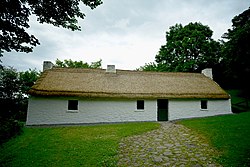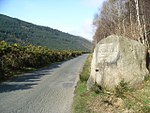Dwyer McAllister Cottage
| Dwyer–McAllister Cottage Irish: Teachín Uí Dhubhuir–Mhic Alastair | |
| County Wicklow | |
|---|---|

| |
| Location | |
| Grid reference: | S96499109 |
| Location: | 52°57’44"N, 6°33’53"W |
| Village: | Derrynamuck |
| History | |
| Built c. 1780 | |
| Thatched cottage | |
| Vernacular | |
| Information | |
| Website: | Dwyer McAllister Cottage |
The Dwyer–McAllister Cottage is a thatched cottage standing in the Glen of Imaal in County Wicklow.[1] It stands on the north-east face of Keadeen Mountain. A stream located to the west of the house flows north for two-thirds of a mile and enters the Little Slaney River.
The cottage has been listed as a National Monument because it was the site of a hopeless last stand by Michael Dwyer and Sam McAllister, of the United Irishmen after the failure of the 1798 Rebellion.
History
In the aftermath of the failed 1798 Rebellion, United Irishmen leader Michael Dwyer continued to fight a guerrilla war against government loyalists and yeomen. On 15 February 1799, he and about a dozen comrades were sheltering in three cottages when a large force of government soldiers descended upon the area, informed of the bandits' location. The cottages were quickly surrounded. The men in the first two cottages surrendered but, following consultation, Dwyer and his men decided to fight on in the third one, Miley Connell's cottage, after negotiating the safe passage of women and children. In the gunfight which followed, the cottage caught fire and only Dwyer remained unwounded. At this stage, Dwyer's comrade, Antrim man Sam McAllister, stood in the doorway to draw the soldiers' fire on him, which allowed Dwyer to slip out and make his escape. Dwyer remained on the run until 1803.
The Dwyer–McAllister Cottage, or 'Dwyer's Cottage', as it is more informally known, was acquired by the Irish State from the Hoxey family on 22 August 1948. The house was extended as a museum in 1992 and is open to the public on summer afternoons from mid-June to mid-September.
Description
The cottage is a detached three-bay single-storey vernacular house, originally built c. 1780, with single-bay portion to the north end, reconstructed in 1992. The walls are constructed in coursed rubble; the pitched roof is thatched and has whitewashed rubble chimneystacks. The entrance is a timber tongue and groove half door whilst the window openings are flat-headed and have replacement 'pivot' timber windows. Internally there are three rooms opening off each other, with whitewashed walls, earthen floors and exposed roof timbers.[2]
Outside links
- Dwyer McAllister Cottage: Heritage Ireland
- Dwyer–McAllister Cottage: Visit Wicklow
References
- ↑ Dwyer McAllister Cottage: Heritage Ireland
- ↑ "Dwyer-McAllister Cottage, DERRYNAMUCK, County Wicklow". National Inventory of Architectural Heritage. https://www.buildingsofireland.ie/buildings-search/building/16402801/dwyer-mcallister-cottage-derrynamuck-county-wicklow. Retrieved 24 November 2020.
